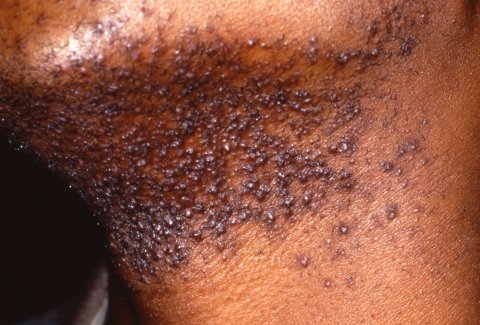Playlist
Show Playlist
Hide Playlist
Folliculitis in Darker Skin: Epidemiology and Etiology
-
Slides Folliculitis in Darker Skin Epidemiology Etiology.pdf
-
Download Lecture Overview
00:01 Welcome to our lecture on bacterial folliculitis. 00:05 So what is bacterial folliculitis? It is defined as superficial or deep bacterial infection of the hair follicle. Bacterial folliculitis or infection around the hair follicle. It's a common skin condition and the exact incidence is unknown since it is usually self-limited and rarely reported. 00:32 The most common cause of bacterial folliculitis is Staphylococcus aureus, as well as Pseudomonas aeruginosa, which usually causes hot tub folliculitis. 00:45 For some of you like soaking in the hot tubs. 00:50 Some of the risk factors include wearing clothing that traps heat and sweat, e.g. rubber gloves or high boots. 01:01 It can also occur as a risk factor due to friction from tight clothing. It's been mentioned that also frequent shaving and plucking or waxing of the beard and hair can cause folliculitis. So in men this may occur on the beard. 01:18 But in women if they shave their armpits or pubic area, you can also get folliculitis on those areas. 01:26 Acne or other follicular skin disorders can also be associated with folliculitis. For example, gram negative folliculitis that we see in patients who have been on long term antibiotics. 01:41 Topical corticosteroids, as they reduce the immunity of the skin, can also predispose to folliculitis. 01:48 So that's why it's important to monitor the duration, the potency and the frequency of using topical corticosteroids. 01:58 Another risk factor is long term use of oral antibiotics for certain conditions. For example, as I mentioned, for acne and other inflammatory conditions like hair scarring disorders. 02:13 The last risk factor that I want to talk about is bathing in an inadequately cleansed hot tub or pool. 02:20 And sometimes you get what we call hot tub folliculitis. 02:26 Clinically, the patient may present with one or more follicular pustules that may be itchy or mildly sore or totally asymptomatic, and they may heal without scarring. 02:37 Sometimes it heals not so much with scars or keloids, but with post-inflammatory hyperpigmentation. 02:45 So in the picture here you can see pustules and numerous grouped pustules. And the economic picture here is that within each pustule you will see a hair follicle in the middle. 02:58 And that tells you that this is a folliculitis that is inflammation occurring around the hair follicle. 03:05 Folliculitis can affect any hair bearing site and most commonly it occurs on the scalp, beard area, axillary and on the buttocks and thighs, and in women it can also occur on the mons pubis after shaving. 03:23 What about folliculitis barbae or sycosis barbae? Recently shaved hair bearing areas in men, e.g. 03:29 beard, are most frequently affected. 03:32 Men who have dark skin or skin of color tend to have a predilection to folliculitis barbae . And again, staph aureus is the most common identified agent. 03:46 On the picture here you can see numerous pustules around the hair follicle. 03:53 Some have coalesced to form plaques. 03:57 So what are some of the complications of folliculitis? One can get cellulitis. 04:02 Lymphangitis bacteremia might result in osteomyelitis, septic arthritis, or pneumonia. 04:10 However, it is good to know that the most common complication is cellulitis, and the rest are not so frequent.
About the Lecture
The lecture Folliculitis in Darker Skin: Epidemiology and Etiology by Ncoza Dlova is from the course Bacterial Skin Infections in Patients with Darker Skin.
Included Quiz Questions
Which organism is most commonly associated with "hot tub folliculitis"?
- Pseudomonas aeruginosa
- Staphylococcus aureus
- Streptococcus pyogenes
- Propionibacterium acnes
- Malassezia furfur
What is the most common complication of bacterial folliculitis?
- Cellulitis
- Osteomyelitis
- Septic arthritis
- Pneumonia
- Bacteremia
Customer reviews
5,0 of 5 stars
| 5 Stars |
|
5 |
| 4 Stars |
|
0 |
| 3 Stars |
|
0 |
| 2 Stars |
|
0 |
| 1 Star |
|
0 |




